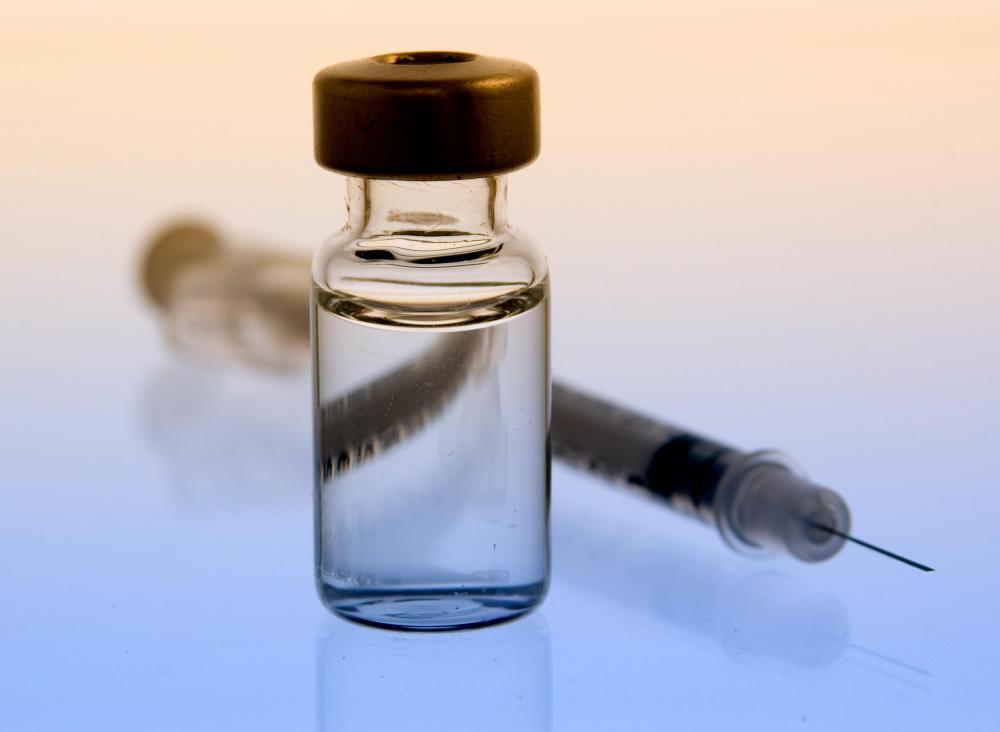At AllThingsNature, we're committed to delivering accurate, trustworthy information. Our expert-authored content is rigorously fact-checked and sourced from credible authorities. Discover how we uphold the highest standards in providing you with reliable knowledge.
What Drugs are Used in Veterinary Anesthesia?
Veterinary anesthesia is used to induce a state of unconsciousness in an animal. It is used during veterinary surgery, and is often required for diagnostic procedures since animals usually won’t remain still long enough for certain tests to be performed. The drugs used for veterinary anesthesia are usually inhalants or injections, and the anesthetics used on animals are the same drugs used on humans.
An anesthetic serves three main purposes: immobilization, unconsciousness, and analgesia or pain relief. Some drugs can provide all of these effects when used alone, but a combination of drugs is frequently used in veterinary anesthesia. Sedatives may be used to immobilize the animal, an analgesic is employed to relieve pain, and another drug may be administered to induce unconsciousness. A common combination is the use of opiates and tranquilizers to sedate an animal before a state of general anesthesia is induced. Opiates won’t bring about a state of unconsciousness in an animal, but they are used for pain relief, while the tranquilizers will relax and calm the animal.

Guaifenesin is sold over the counter as an expectorant for people, and it is used in veterinary medicine to relax the animal before a general anesthetic is administered. Ketamine is often used as an anesthetic for both children and animals. It is frequently used in combination with midazolam or diazepam for veterinary anesthesia, both of which are also used to sedate humans. Morphine is another drug commonly used for sedation in both humans and animals.

Barbiturates are frequently used in veterinary anesthesia to induce short term unconsciousness. Thiopental is the most-commonly used barbiturate for this stage of anesthesia but other, non-barbiturate drugs have also gained popularity for anesthetic purposes. Propofol, when administered intravenously, provides a quick onset of unconsciousness but has no effect on pain, so it must be used in conjunction with an analgesic. Since drugs in combination often have a synergistic effect, the dosages can be much smaller than when each drug is used alone.

Anesthetics affect different species in different ways, so a drug that will be safe and effective on one type of animal may be harmful to another. For example, morphine is frequently used to sedate dogs, but when administered to a horse may cause mania. Midazolam will sedate guinea pigs and rabbits, but it has the opposite effect on cats and dogs, inducing a state of excitement. A veterinarian may encounter a variety of species in his or her practice, and must have the knowledge of the effect the different veterinary anesthesia drugs may have on each patient.
Frequently Asked Questions
What are the most common drugs used for inducing anesthesia in animals?

For inducing anesthesia in animals, veterinarians often use drugs like propofol, ketamine, and alfaxalone. Propofol is favored for its rapid onset and short duration of action. Ketamine is used for its analgesic properties and is often combined with sedatives. Alfaxalone is known for maintaining good cardiovascular stability during induction.
Are there any inhalant anesthetics commonly used in veterinary medicine?

Yes, inhalant anesthetics such as isoflurane and sevoflurane are widely used in veterinary medicine due to their adjustable depth of anesthesia and minimal metabolism by the body. Isoflurane is known for its safety profile and is cost-effective, while sevofurane offers a more rapid adjustment of anesthetic depth and quicker recovery times.
How do veterinarians choose the appropriate anesthetic for a particular animal?

Veterinarians select anesthetics based on the animal's species, breed, age, health status, and the procedure's duration and complexity. They also consider the drug's side effects and interactions with other medications the animal may be taking. A thorough pre-anesthetic evaluation helps tailor the anesthetic protocol to each individual animal's needs.
What role do analgesics play in veterinary anesthesia?
Analgesics play a crucial role in veterinary anesthesia by providing pain relief, which is essential for animal welfare. They can reduce the amount of general anesthetic needed and help manage post-operative pain. Opioids like morphine and fentanyl are commonly used for their potent analgesic effects and can be administered before, during, or after surgery.
Can local anesthetics be used in veterinary procedures?
Local anesthetics are frequently used in veterinary procedures to numb specific areas of the body. Drugs like lidocaine and bupivacaine are applied topically or injected to block nerve impulses, providing pain relief for minor surgeries or diagnostic procedures without the need for full sedation or general anesthesia.
Are there any risks associated with veterinary anesthesia?
As with human anesthesia, there are risks associated with veterinary anesthesia, including respiratory and cardiovascular complications. The risk level depends on the animal's overall health, age, and the type of anesthetic used. Pre-anesthetic assessments and monitoring during anesthesia help minimize these risks and ensure the animal's safety throughout the procedure.
AS FEATURED ON:
AS FEATURED ON:
















Discuss this Article
Post your comments